
2022 Global freelancer income report: The ongoing rise of the freelance revolution
Introduction
The past two years have brought unprecedented disruptions to the global employment market. As billions around the world continued to shelter against COVID-19, the global work force, including millions of freelancers, has adapted to a new reality.
In this fourth edition of the Freelance Income Report, using data from a survey of 2,000 Payoneer customers from over 100 countries who work with international clients, we set out to better understand who today’s freelance workers are, what unique challenges they face, and how they are weathering the global pandemic.
As you will see, the results show that not only were most freelancers able to maintain their levels of work and income during these tumultuous times, but a third of them experienced a growing demand, and 40% even saw an uptick in rates during the pandemic.
In some respects, this should not come as a surprise. The flexibility that freelancers offer their clients lends itself to the uncertainty created by waves of pandemic surge and retreat. For many companies, freelancers serve as a lifeline in filling essential functions, especially in the shadow of what has been described as the ‘great resignation’ or when an unpredictable market creates a need for a more agile workforce.
Furthermore, in an increasingly remote ‘work from anywhere’ world, businesses are now much better equipped to onboard remote freelancers than before.
To a large extent, freelancers were better prepared for this new reality than most workers. After all, working from home has been a way of life for many freelancers for some time. The results of this survey provide a unique window into how these global freelancers operate and what makes them successful.
Although we cannot predict exactly what the world will look like in the coming years, the proven adaptability of freelance workers suggests the share of freelancers in the global workforce will very likely continue to grow.
Key findings
| 32% of respondents reported higher demand for their services since the COVID-19 pandemic began, with a further 45% saying demand stayed constant without slowing. | |
| The worldwide average hourly freelance rate is $28, much higher than the $21 average rate two years ago. | |
| The fields of programming, marketing, and finance showed the strongest growth in demand. | |
| Younger freelancers were the main beneficiaries in the surge in demand, while more seasoned freelancers saw a slight slowdown. | |
| 40% reported higher hourly rates since the start of the pandemic. Only 12% saw a decrease in rates. | |
| Despite the increased representation and higher rates of education among women, the gender pay gap persists, and has even widened slightly since our 2020 Global Freelancer Income Report. Women are making 82% of what their male counterparts make, at $23/hour on average compared to men’s $28/hour. | |
| The fastest growing specialties – finance, marketing, and programming – are among the top earning professions, while the lowest-earning freelancing specialties are in decline. | |
| Female participation has increased from 24% to 29% since the 2020 Global Freelancer Income Report. | |
| Younger freelancers were able to command higher rates, offering them a bright future in a growing freelancing market. | |
| LinkedIn, Instagram, and YouTube continue to gain popularity among freelancers, inching closer to Facebook as the top platform for freelancers to promote their work |
A changing world is driving higher demand for a flexible workforce
While global unemployment reached historic highs throughout the last two years of the pandemic, freelancers as a whole appear to have weathered the disruptions relatively well. The overall share of freelancers grew with COVID-19, as some workers were pushed to find alternatives to traditional work and others were pulled by the newly available opportunities to work remotely. Upwork reports that 12% of the workforce started freelancing in 2020.
Despite the surge of new competition, our survey indicates that demand remained high. Since the start of the pandemic, a large majority saw either an increase or no change in demand, with less than a quarter of survey respondents reporting a reduction.


The impact of COVID-19 is even more pronounced when it comes to rates commanded by freelancers. As many as 40% reported higher
post-pandemic rates, while only 12% saw rates decline.


The worldwide average hourly freelance rate
The worldwide average hourly rate charged by freelancers is $28, significantly higher than the $21 average hourly rate reported in our 2020 Global Freelancer Income Report.
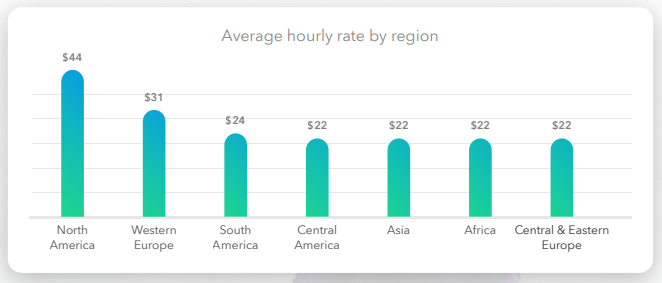

The most popular fields are not the ones providing the highest pay
As we have also seen in past reports, the most popular fields are not necessarily the ones providing the highest pay. After all, clients are more likely and willing to pay higher rates for professions which are more specialized and have less qualified practitioners in them. Likewise, those fields which are more popular and have a large number of freelance professionals in them are more likely to have downward pressure on rates due to higher levels of competition.
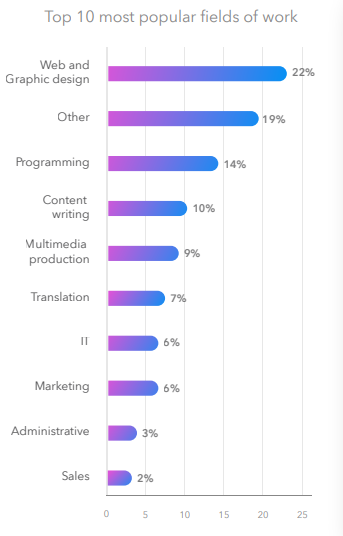  |
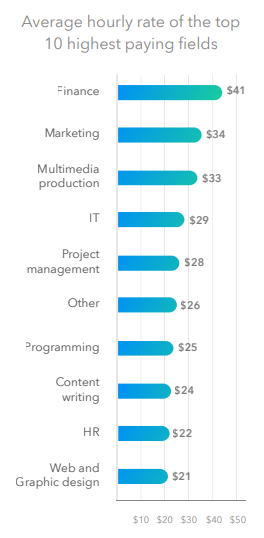  |
Programming, finance and IT surge
While the industry as a whole was able to persevere, demand for freelance work shifted unevenly across different sets of skills. Fields that saw particularly higher demand include programming and finance, while customer support exhibited the most significant decline.
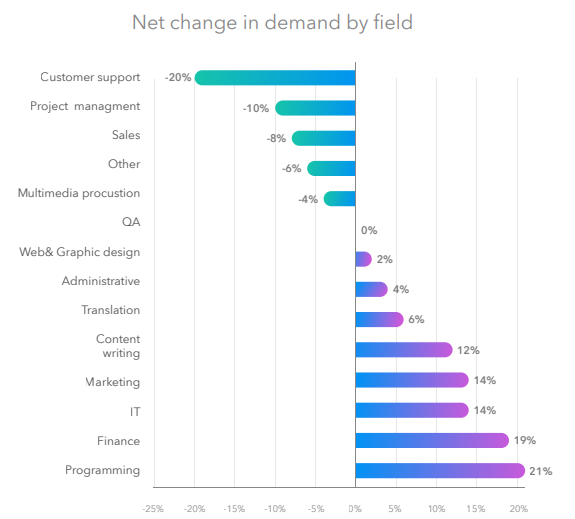

As waves of younger people finished their full-time education over the last couple of years, and with the job market hit hard by the pandemic, it is not surprising to see that the surge in freelancing popularity and demand particularly benefited younger workers.


More seasoned freelancers, however, claim to have experienced a somewhat of a slowdown in demand, and those over 65 experienced the most dramatic decline. Broken down by region, we can see that the younger age groups make up an overwhelming majority of the freelancer market in Asia and Africa. and in almost all regions worldwide, the largest age group is the 25-34 bracket, closely followed by the
19-24 age group.
Age distribution by region
  |
  |
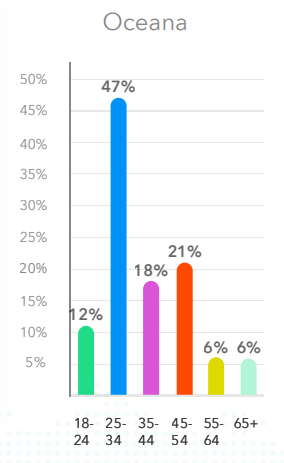  |
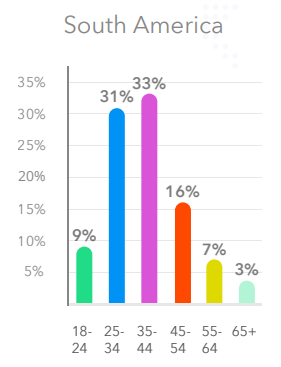  |
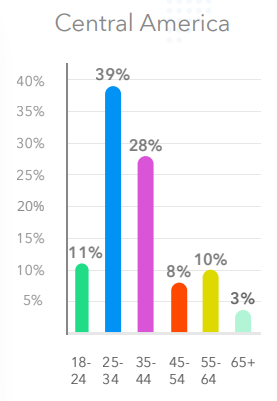  |
  |
Shifting work environments can open the door for greater female participation
The share of women responding to this survey has exhibited modest incremental growth since Payoneer began these reports in 2015. This year, however, we saw a welcome increase in women’s participation, up to 29% compared with 24% in 2020’s Freelance Income Report, though there is still some way to go to reach parity.
This growth is particularly notable when considering that women were hit harder than men by job losses due to the pandemic. Indeed, a less promising employment outlook may have opened the door for more women to enter the digital economy.


In addition, a report from the Association for Independent Professionals and the Self-Employed found that a more flexible work arrangement and the potential for higher earnings are cited as key reasons why participation in the freelance workforce by women has grown 57% over the last decade.
The gender pay gap persists, with some bright spots ahead
Even in the face of increased representation and higher rates of education among women, the gender pay persists, with women making $23/hour on average to men’s $28/hour. At 82% of the average man’s hourly rate, this is a slight widening of the gap since our 2020 Freelance Income Report which showed women earning, on average, 84% of what male freelancers earn.
As seen in the chart below, the gap differs according to region. It should also be noted that where the female hourly rate is higher than men’s, for example, in South America, it is likely influenced by the higher paid industries that are more in demand in these regions.
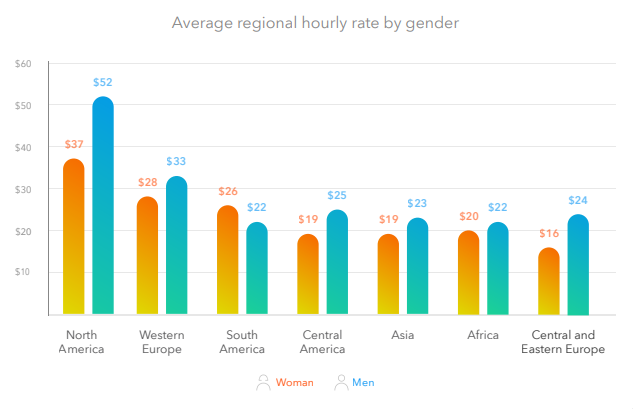

This trend was also witnessed on an international level, with the World Economic Forum reporting that the Global Gender Gap has widened slightly since 2020. Overall, they note that the wage gap between female and male workers is 37%, significantly higher than the disparity in freelancing. This suggests that, while women have yet to gain equal access to economic opportunity, the playing field is more level in the freelancing market than in traditional employment markets.


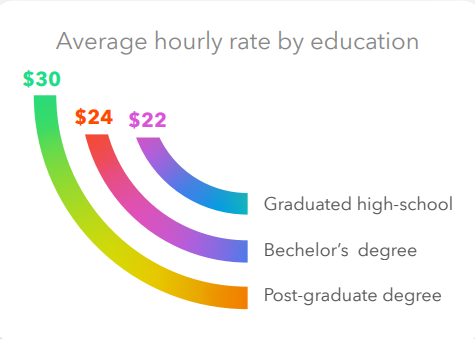

Despite the pay gap, women report higher satisfaction from freelancing than men. Women that work exclusively as freelancers are particularly satisfied, suggesting that a full-time freelance position may provide autonomy that’s highly valued.
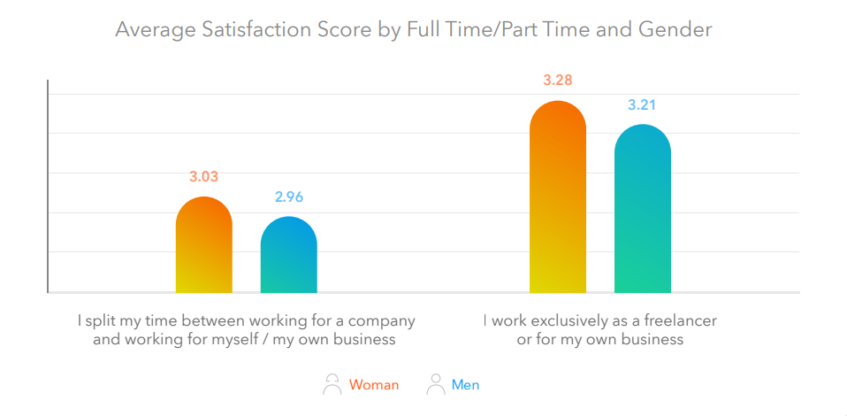

Freelancers are highly satisfied and excited for the future
Reflecting well on the industry is that a clear majority of respondents reported being satisfied with the freelancing lifestyle. Impressively, over one-third of the respondents said they are very satisfied, 83% said they were satisfied or very satisfied, and only a mere 3% feel unsatisfied.
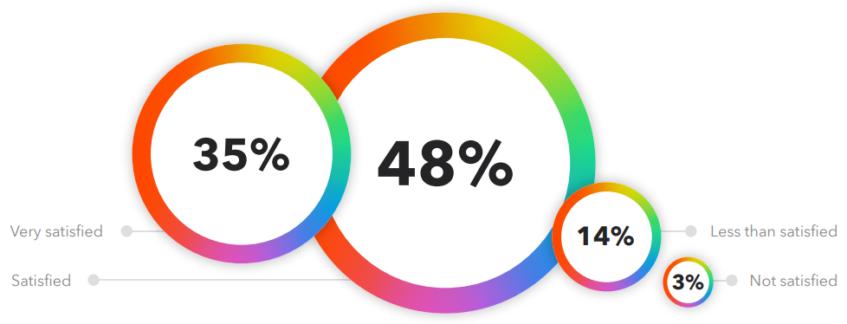

Even more impressive is how positive freelancers are about the future of their work. Close to 75% of respondents believe demand will continue to grow and allow them to expand their business, while only 3% predict their business will slow down.
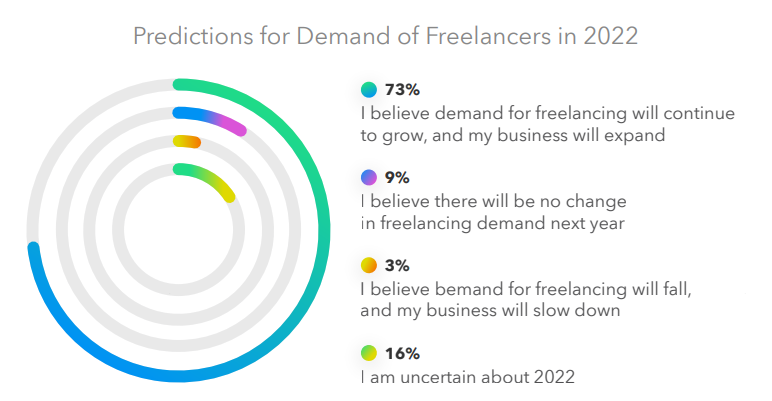

Marketplaces are where the work is
It is no surprise that freelancers today get most of their business via online marketplaces. A large majority (71%) of the respondents find most of their work through online marketplaces, while only 10% rely on more traditional sources like word of mouth (often by way of email or social media introductions) and referrals.
With this in mind, it may not be too much of an exaggeration to say how much freelancers owe their livelihoods to platforms such as Fiverr, Upwork, People Per Hour, 99 Designs, and others, who have essentially been powering the freelance revolution over the past 20 years. Without these platforms, freelancers would be more limited in the number of clients they work for, the revenues they make and the potential to expand their businesses across borders.
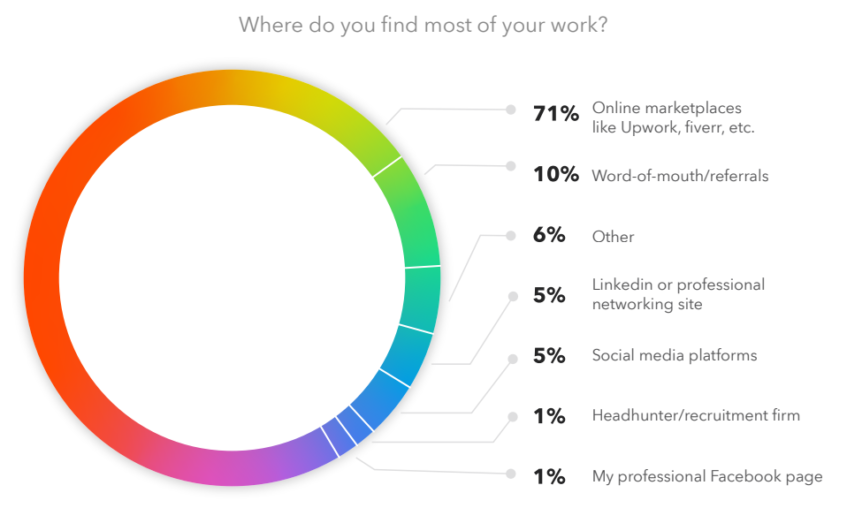

LinkedIn Marketplace, which was launched in October 2021, is quickly gaining popularity among freelancers, especially the younger ones.
Freelancers are a social bunch
While only 5% of respondents say their main source of new work is through social media, two-thirds of the respondents use a myriad of social platforms to promote their businesses. When comparing the results to our 2020 Freelance Income Report, it is clear that LinkedIn, Instagram, and YouTube continue to gain popularity, inching closer to Facebook as the leading social platform for freelancers.
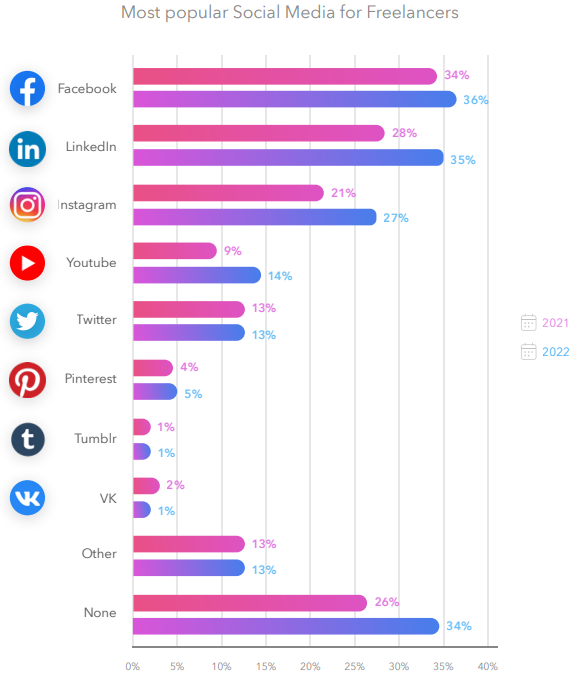

Takeaways: Opportunities are on the rise in an uncertain world
In many ways, freelancing provides an answer to our new world defined by uncertainty. As the global workforce continues to respond to the stresses of the pandemic, freelance workers demonstrate impressive resilience. Many freelancers, and in particular many young freelancers, have seen both an increase in demand and a raise in their hourly rates over the past year.
Indeed, over the last two years there has been a significant increase in the average global hourly freelancing rate from $21 to $28, likely caused by the 40% of freelancers who are now charging more for their services since the start of the pandemic.
Still, the success is not evenly distributed, and there is work to be done to make freelancing more equitable. While there has been an increased number of women entering the world of freelancing, women freelancers continue to lag in pay behind their male counterparts, with that gap growing over the past two years. At the same time, though, women reported higher levels of satisfaction, revealing the ongoing potential of freelancing to offer women an attractive alternative to the traditional workforce.
Regardless of hourly rates, though, nearly all freelancers surveyed expressed high levels of satisfaction with their jobs. Given the unparalleled levels of global turmoil, the relative triumph of the freelance community during these times is no small feat. We anticipate that this passion and satisfaction for the freelancing lifestyle, along with the new work paradigms that the pandemic has given rise to, will continue to fuel the growth of freelancing for many years to come.
The payments platform built for freelancers
Payoneer is the world’s leading commerce enablement platform, empowering freelancers to realize their potential by connecting with marketplaces and clients worldwide.
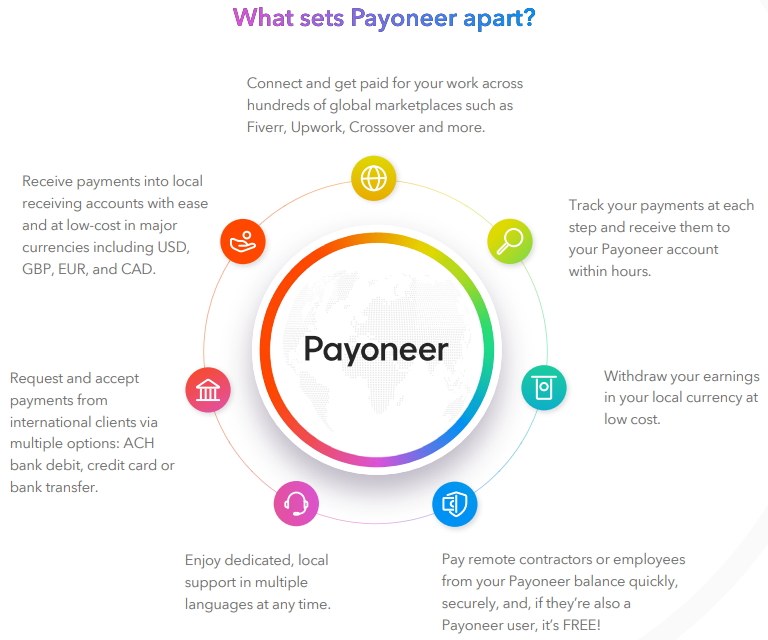

| I’m a freelancer Learn More |
I’m a marketplace Learn More |




